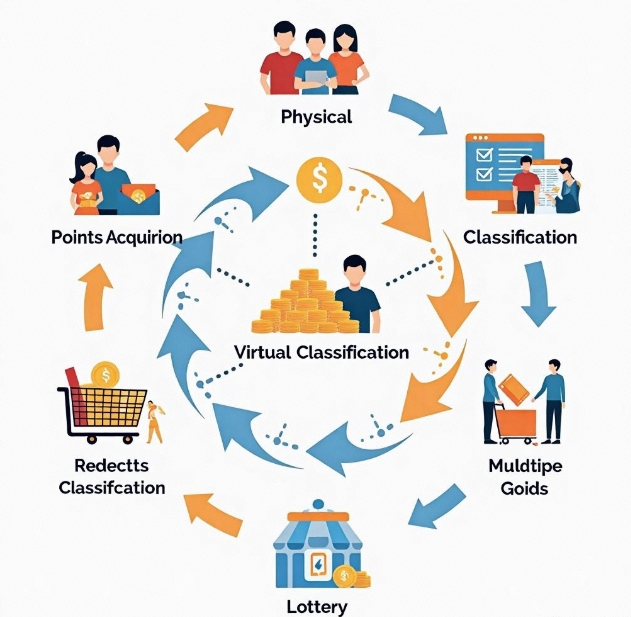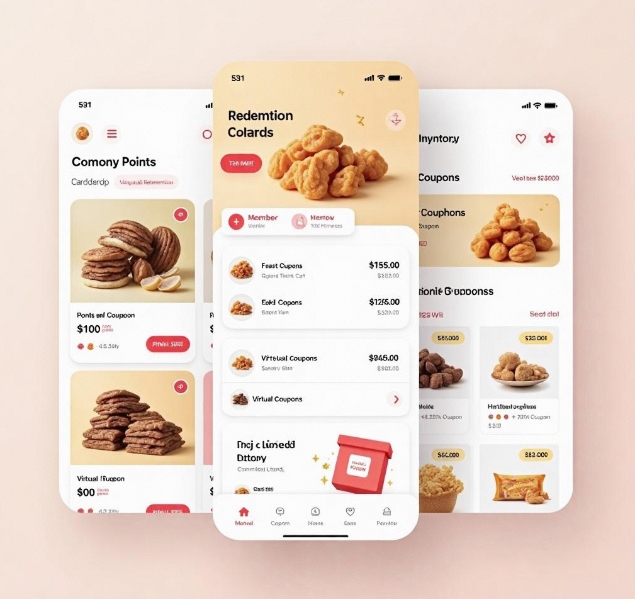How should the product redemption mechanism in the points mall be designed?
- latest articles
- 1.DApp Development & Customization: Merging Diverse Market Needs with User Experience 2.Analysis of the Core Technical System in DApp Project Development 3.How to achieve cross-chain interoperability in Web3 projects? 4.How does the tokenization of points reconstruct the e-commerce ecosystem? 5.How to Set and Track Data Metrics for a Points Mall? 6.What is DApp Development? Core Concepts and Technical Analysis 7.Inventory of commonly used Web3 development tools and usage tips 8.Development of a Distribution System Integrated with Social E-commerce 9.Six Key Steps for Businesses to Build a Points Mall System 10.What is DApp Development? A Comprehensive Guide from Concept to Implementation
- Popular Articles
- 1.Future Trends and Technology Predictions for APP Development in 2025 2.Analysis of the DeFi Ecosystem: How Developers Can Participate in Decentralized Finance Innovation 3.From Zero to One: How PI Mall Revolutionizes the Traditional E-commerce Model 4.DAPP Development | Best Practices for Professional Customization and Rapid Launch 5.Recommended by the Web3 developer community: the most noteworthy forums and resources 6.From Cloud Computing to Computing Power Leasing: Building a Flexible and Scalable Computing Resource Platform 7.How to Develop a Successful Douyin Mini Program: Technical Architecture and Best Practices 8.Shared Bike System APP: The Convenient Choice in the Era of Smart Travel 9.How to Create a Successful Dating App: From Needs Analysis to User Experience Design 10.From Design to Development: The Complete Process of Bringing an APP Idea to Life
In today's digital wave sweeping across all industries, points malls, as an important component of user operations and membership systems, are increasingly widely used in e-commerce, finance, education, communities, and internal corporate incentive systems. A well-designed points mall redemption mechanism can effectively enhance user activity, increase user stickiness, optimize customer lifetime value (CLV), and even become a significant reflection of brand competitiveness.
So, how should the product redemption mechanism of a points mall be designed? This article will systematically analyze it from multiple aspects such as mechanism design objectives, core elements, common strategies, risk control, and user experience optimization, to help enterprises or platforms avoid detours in the design process and maximize value.
I. Core Objectives of Designing a Redemption Mechanism
Before delving into the details of the redemption mechanism, we need to clarify its core objectives:
Incentivize User Activity and Retention
The points redemption mechanism should encourage users to frequently visit, use platform services, and continuously participate in tasks or transactions, thereby enhancing overall user activity and repurchase rates.Balance Value and Cost
Provide attractive rewards to users while controlling redemption costs to ensure the sustainability of the enterprise's economic model.Drive User Behavior
The points mall should guide users to perform behaviors desired by the platform, such as signing in, sharing, shopping, reviewing, and recommending.Strengthen Brand and User Relationships
Enhance users' sense of identity and belonging to the brand through personalized and emotional reward mechanisms.
II. Core Elements of the Points Mall Redemption Mechanism
To design an effective redemption mechanism, start with the following key modules:
1. Selection of Product Types
Physical Goods: Such as electronic products, daily necessities, brand merchandise, etc., which have real value and strong appeal.
Virtual Goods: Including coupons, membership benefits, digital vouchers (e.g., video VIPs, in-game items, etc.), which are cost-controllable and flexible to distribute.
Exclusive Services: Such as priority customer service, birthday privileges, customized services, to enhance users' sense of exclusivity.
Lottery or Blind Box Items: Stimulate user participation through gamification.
Recommendation: Initially focus on virtual goods and coupons to reduce costs; gradually introduce high-value physical goods and customized products as operations mature.
2. Design of Redemption Thresholds
Points Quantity Setting: Should be proportional to the product value and user points acquisition speed to prevent inflation.
Level Restrictions: Set membership level requirements for certain products to motivate users to upgrade.
Cycle Restrictions: Such as "only one redemption per month" or "limited-time redemption" to create a sense of scarcity.
Combination Redemption: For example, "1000 points + 1 yuan cash" for product redemption to enhance realism.
3. Product Inventory and Update Frequency
Limited Quantity Mechanism: Increases urgency and scarcity.
Dynamic New Arrivals: Keeps the mall fresh and stimulates regular user visits.
Exclusive Product Pool: Display different products for different user segments (e.g., VIP user redemption zone).
4. Points Value System
It is necessary to assign a reference value to each point to maintain consistency in user psychological expectations. For example: 1 point ≈ 0.01 yuan, but allow for moderate fluctuations, such as enhancing the perceived value when redeeming coupons.
III. Common Redemption Strategies and Engagement Designs
1. Tiered Redemption Mechanism
This means the higher the number of points, the higher the value of the redeemable goods. This method encourages users to accumulate points and enhances platform stickiness.
Example:
| Points Required | Redeemable Goods |
|---|---|
| 500 | 5 Yuan Coupon |
| 2000 | Brand Mug |
| 10000 | Smart Speaker/Bracelet, etc. |
2. Lottery + Redemption Hybrid Mechanism
Introduce a "luck" factor through points lotteries or points blind boxes to increase fun and participation rates. For example:
100 points for one lottery draw, with a chance to win physical prizes;
Users can use points to open blind boxes and receive random benefits.
3. Limited-Time/Limited-Quantity Flash Sales
Increase user urgency and desire to participate by setting up methods like "hourly flash sales," "holiday specials," or "member day exclusives."
4. Task-Driven Redemption Entry
Users complete tasks to earn points or redemption eligibility. For example:
Sign in for 7 days to redeem an "exclusive badge";
Share with a friend who successfully registers to redeem "brand merchandise."
IV. Risk Control and Cost Management
Although points malls are highly valuable in user operations, improper design can easily lead to cost overruns, user cash-outs, point farming, and other issues. Therefore, the following control strategies should be embedded in the mechanism design:
1. Prevent Point Farming and Bulk Redemptions
Set redemption frequency and total limit restrictions;
Integrate risk control systems to identify abnormal user behavior;
Add manual review processes for high-value product redemptions.
2. Refined Points Issuance Rules
Carefully design points acquisition channels and daily limits;
Award points with different weights based on user levels and behavior paths;
Set points expiration dates and cleanup mechanisms.
3. Dynamic Adjustment of Cost Models
Set cost coefficients and total budgets for all products;
Regularly review the points pool and product inventory, replacing products or adjusting points prices;
Flexibly adjust in conjunction with holiday events or marketing promotion plans.
V. User Experience Optimization Recommendations
1. Clear Visibility of Points Acquisition and Usage Paths
Users should always know their current points balance, redeemable products, and redemption history. Enhance transparency through charts, prompts, and operational guidance.
2. Strengthen Product Visual Presentation and Emotional Connection
Optimize product display images and descriptions;
Set up user "wish lists" or "save for later" features;
Introduce user sharing and reviews to create an authentic word-of-mouth atmosphere.
3. Personalized Recommendations and Smart Matching
Recommend products based on user behavior and preferences;
Set up redemption entries, exclusive benefits, and activities corresponding to different user profiles.
4. Multi-Device Synchronization and Cross-Platform Integration
Ensure the points system is consistent across apps, mini-programs, official websites, and other platforms, with timely feedback on redemption results for a seamless user experience.
VI. Typical Case Analysis (Brief)
JD.com Points Mall: Combines various redemption modes like coupons, physical goods, and lotteries to form a user stickiness loop.
Alipay Membership System: Designs different rights redemption pools based on levels and behaviors, strengthening user segmentation.
Bilibili Annual Points Program: Encourages points acquisition through user interaction and creation incentives, used to redeem UP主 merchandise and virtual items, enhancing community vitality.
Conclusion
The design of a points mall redemption mechanism is not as simple as "listing some products and setting prices"; it is a systematic project that integrates business strategy, user operations, technical logic, and risk management. It requires continuous optimization and dynamic adjustment to exert its true leverage effect in the fierce battle for users.
When properly designed, a points mall can not only become an "accelerator" for user activity but also a "bonding agent" for brand stickiness, ultimately achieving a win-win situation for both the enterprise and its users.
-

How does the tokenization of points reconstruct the e-commerce ecosystem?
With the continuous advancement of internet technology and the gradual prolifera···
-

How to Set and Track Data Metrics for a Points Mall?
With the rapid development of the e-commerce industry, points malls, as a common···
-

Development of a Distribution System Integrated with Social E-commerce
With the rapid development of internet technology, the e-commerce industry has e···

 Blockchain
Blockchain












